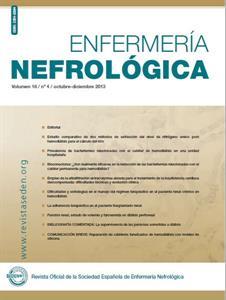Contenido del artículo principal
Resumen
Objetivo: Evaluar si existen diferencias en el cálculo del Kt/V entre 2 métodos de extracción del BUN post HD.
Metodología: Estudio prospectivo comparativo en una cohorte de pacientes en hemodiálisis crónica. Se cuantificó el Kt/V durante dos semanas consecutivas mediante la fórmula de Daugirdas de segunda generación. La extracción de la muestra de sangre para el BUN post hemodiálisis se realizó mediante 2 métodos: disminución del flujo de bomba de sangre a 50ml/min durante 2 minutos, inmediatamente antes de finalizar la sesión (método A); y a los 10 minutos tras finalizar la sesión de hemodiálisis (método B).
Resultados: 47 pacientes estudiados: 66% hombres, edad media de 66±13 años, 51% FAVI, 59,5% hemodiafiltración on-line. La media del Kt/V durante las dos semanas del estudio para el método A fue de 1,51 y para el método B de 1,41 (p<0,001). Existieron diferencias estadísticamente significativas según la técnica de hemodiálisis y el acceso vascular entre ambos métodos de extracción. El coeficiente de correlación de Pearson sin embargo, mostró una correlación casi lineal entre las medias del Kt/V de ambos métodos (r=0.954). La diferencia entre ambos métodos fue del 10%.
Conclusiones: Existen diferencias significativas en el cálculo del Kt/V entre la extracción del BUN post hemodiálisis por el método A y B, siendo mayor la dosis obtenida por el primer método. Sin embargo, ambas mediciones se correlacionan bien, teniendo en cuenta que con la extracción a los 10 minutos se produce una disminución del 10% sobre el otro método.
Metodología: Estudio prospectivo comparativo en una cohorte de pacientes en hemodiálisis crónica. Se cuantificó el Kt/V durante dos semanas consecutivas mediante la fórmula de Daugirdas de segunda generación. La extracción de la muestra de sangre para el BUN post hemodiálisis se realizó mediante 2 métodos: disminución del flujo de bomba de sangre a 50ml/min durante 2 minutos, inmediatamente antes de finalizar la sesión (método A); y a los 10 minutos tras finalizar la sesión de hemodiálisis (método B).
Resultados: 47 pacientes estudiados: 66% hombres, edad media de 66±13 años, 51% FAVI, 59,5% hemodiafiltración on-line. La media del Kt/V durante las dos semanas del estudio para el método A fue de 1,51 y para el método B de 1,41 (p<0,001). Existieron diferencias estadísticamente significativas según la técnica de hemodiálisis y el acceso vascular entre ambos métodos de extracción. El coeficiente de correlación de Pearson sin embargo, mostró una correlación casi lineal entre las medias del Kt/V de ambos métodos (r=0.954). La diferencia entre ambos métodos fue del 10%.
Conclusiones: Existen diferencias significativas en el cálculo del Kt/V entre la extracción del BUN post hemodiálisis por el método A y B, siendo mayor la dosis obtenida por el primer método. Sin embargo, ambas mediciones se correlacionan bien, teniendo en cuenta que con la extracción a los 10 minutos se produce una disminución del 10% sobre el otro método.
Palabras clave
dosis de diálisis; hemodiálisis; extracción sanguínea; nitrógeno ureico.
Detalles del artículo
Licencia
Aviso de derechos de autor/a
© Los autores ceden de forma no exclusiva los derechos de explotación de los trabajos publicados y consiente en que su uso y distribución se realice con la Licencia Creative Commons Atribución - No comercial 4.0 Internacional (CC BY-NC 4.0). Puede consultar desde aquí la versión informativa y el texto legal de la licencia. Esta circunstancia ha de hacerse constar expresamente de esta forma cuando sea necesario.
Cómo citar
1.
Cobo Sánchez JL, Pelayo Alonso R, Cuadrado Mantecón ME, Villa Llamazares C, Pérez Garmilla AI, Aja Crespo A, et al. Estudio comparativo de dos métodos de extracción del nivel de nitrógeno ureico post hemodiálisis para el cálculo del kt/v. Enferm Nefrol [Internet]. 2014 [consultado 11 Sep 2025];16(4):[aprox. 6 p.]. Disponible en: https://enfermerianefrologica.com/revista/article/view/4171




